Category : Dyno Test & Tune
Back to Blog
Share This
All these results were done using a product we no longer support, or care to even mention the brand name! This info is just showing we were first to the EVO X tuning game...
This test was done on our 08 EVO X shop car. The important things to note is that this is a totally stock 2008 EVO X. The only thing done is the Unichip and our custom tune. Our first dyno results showed the EVO making very decent WHP. In fact it was high enough that some guys on the internet we questioning our numbers. But using logic and comparing this to the numbers we saw on the STI they start to make sense. The STI has shown to be a little slower than the EVO in some tests, and since the EVO weighs quite a bit more, this explains how it can be faster. The X is rated at 291HP and 300ft-lbs of torque at the engine. When we first dynoed the car we were seeing a very consistent 260WHP and 280ft-lbs of torque at the wheels. Using these numbers we can say that our EVO X has very little drive train losses, or these are underrated as far as engine horsepower. Compared to others on the Internet our numbers were a little high, which may make our overall numbers different, but whats important is the difference in the before and afters! Our dyno we are using is a Dynapack dyno. This dyno seems to be pretty close to a local mustang dyno in how it reads for most cars. All of our runs are done in 3rd gear, and run for 14 seconds. Both of these factors play into the actual HP and TQ numbers we see. These factors are important to mention and important to understand as they can be manipulated to change the results. We could have made the dyno read a bit lower, by changing to 4th gear, or making the run shorter, but for tuning purposes, and future part comparos, this is what we decided on. Since the EVO X came out, everyone has been crying for engine management. The car runs low boost at upper RPMs and the car runs really rich. Both are good indicators of how much more potential power there is to be had. ECU flashing methods are along ways away from happening, so the next best thing is a piggyback type of ECU. In the past this type of ECU gets a bad name because of certain cars and how they work in conjunction with their ECU€™s. With the EVO X, there are some mysteries as to how it would work, but we were willing to try it. We have been using the Unichip successfully on some Mini Cooper applications, and using it to do the simple things like modify the MAF signal, retard or advance the crank signal, and trick the MAP sensor are what it does best. The Unichip is a simple but complicated ECU for your X. Its simple is what its doing (modding signals going to and from the engine and ECU) but complicated in how it does it. The simple part for us is in the tuning. Its just plus or minus from its base of 0. The internal tables are setup on load (13 cells high) versus RPM (24 cells long). What is nice is that the load can change from map to map. So one map can use boost for load, another can use TPS, or whatever. It€™s a very flexible tool for the X in how it can be setup, which is why we were so quick to come out with it.Let the Tuning begin€¦€¦€¦.
The first thing we started changing was boost. The stock X makes about 23psi of peak boost. So on our Stage 1 setup (bone stock X) we wanted to push it at 23psi and see what we can do. Knowing that our car run pretty well with 23psi on our Manual Boost Controller, we knew it would be perfectly fine to run it on the Unichip.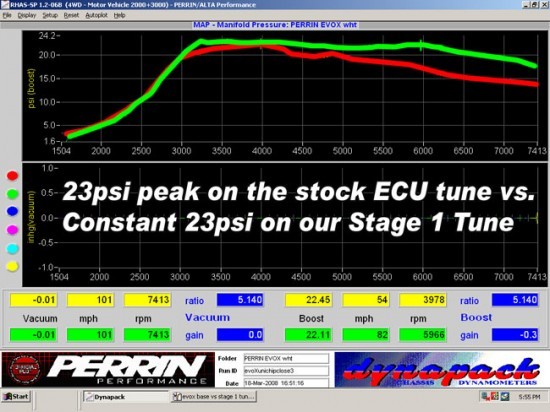 More boost, more power...........Duh!
You can see that the stock boost solenoids can do a good job of hold 23psi of boost to redline. The EVO being able to hold that kind of boost at redline shows it comes with a pretty big turbo. We could have gone a little higher (which we did a few times) but we felt this was a little too much for stock cats, and it was already making big power, even with the back pressure of the stock exhaust. When we do our turbo back exhaust tune (Stage 2), we will push it up a couple PSI and see what she can do. Of course adding boost is a great way to get more power, but will it gain more from fueling??
Everyone that has dynoed the X have all seen the same thing. Stupid rich Air Fuel Ratios! Nearly on the verge of misfires, we were expecting huge gains with some fuel retuning. We did and didn€™t see huge gains from this. The way the Unichip changes fueling is by modifying the stock MAF sensor voltage. But in doing so it changes timing. Because of how the internal maps are setup, less air flow (less voltage from the sensor) means more timing, and of course the opposite is true. So as we remove fuel it adds timing. When the amount of fuel we were removing, we were seeing huge increases in power, but this was from timing and fueling together.
Lots of guys were thinking there was huge power to be had by leaning it out. We actually found that the X likes it a little rich. The older EVO engines seemed to run fine at leaner AFR€™s, and they made great power. But the new one didn€™t gain much power running too much leaner than 11.5. In fact it ran 12-1 but the power wasn€™t even 10HP different. Because of the Stage the car is in, this could be why it didn€™t gain anymore. When we do the turboback exhaust, the who knows!
More boost, more power...........Duh!
You can see that the stock boost solenoids can do a good job of hold 23psi of boost to redline. The EVO being able to hold that kind of boost at redline shows it comes with a pretty big turbo. We could have gone a little higher (which we did a few times) but we felt this was a little too much for stock cats, and it was already making big power, even with the back pressure of the stock exhaust. When we do our turbo back exhaust tune (Stage 2), we will push it up a couple PSI and see what she can do. Of course adding boost is a great way to get more power, but will it gain more from fueling??
Everyone that has dynoed the X have all seen the same thing. Stupid rich Air Fuel Ratios! Nearly on the verge of misfires, we were expecting huge gains with some fuel retuning. We did and didn€™t see huge gains from this. The way the Unichip changes fueling is by modifying the stock MAF sensor voltage. But in doing so it changes timing. Because of how the internal maps are setup, less air flow (less voltage from the sensor) means more timing, and of course the opposite is true. So as we remove fuel it adds timing. When the amount of fuel we were removing, we were seeing huge increases in power, but this was from timing and fueling together.
Lots of guys were thinking there was huge power to be had by leaning it out. We actually found that the X likes it a little rich. The older EVO engines seemed to run fine at leaner AFR€™s, and they made great power. But the new one didn€™t gain much power running too much leaner than 11.5. In fact it ran 12-1 but the power wasn€™t even 10HP different. Because of the Stage the car is in, this could be why it didn€™t gain anymore. When we do the turboback exhaust, the who knows!
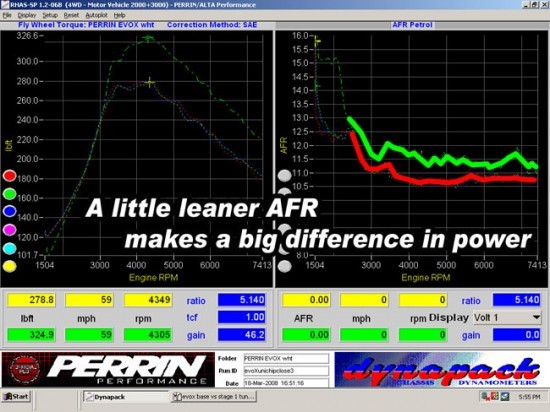 The above graph shows the AFR we were seeing behind the cats (yes there is 2 of them). We normally see a .7-1.0 AFR leaner behind cats.
The above graph shows the AFR we were seeing behind the cats (yes there is 2 of them). We normally see a .7-1.0 AFR leaner behind cats.
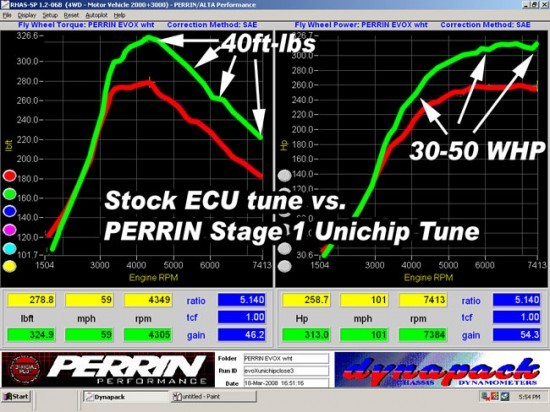 The above graph is pretty self explanatory........
Needless to say, you can feel the difference! 40WHP and 40Ft-lbs is huge, and this is just in Stage 1 form. Running the same peak boost as the stock ECU runs, we were able to make the additional power while keeping things very safe, in our opinion. With this huge safety factor in play, I think there is quite a bit more low-end power to be gained with an exhaust system. (yes we are building them right now).
Before we pulled of the car, we thought we would try out the cone filter mod people are doing. In the past this didn€™t really work out so well because the MAF sensor was so picky. So we were a little skeptical. Turned fueling back to stock in fear it will lean the car out too much. The first couple runs showed it ran .7AFR leaner. This is isn€™t bad as it was close to how we had it tuned. But the runs were not very consistent and would vary 15-20WHP in spots. We spent a little while tuning it, but in the end all that work to get rid of the jumpy power curve wasn€™t worth it. At this point a cone filter is not something we would recommend as an add-on to our Unichip.
The above graph is pretty self explanatory........
Needless to say, you can feel the difference! 40WHP and 40Ft-lbs is huge, and this is just in Stage 1 form. Running the same peak boost as the stock ECU runs, we were able to make the additional power while keeping things very safe, in our opinion. With this huge safety factor in play, I think there is quite a bit more low-end power to be gained with an exhaust system. (yes we are building them right now).
Before we pulled of the car, we thought we would try out the cone filter mod people are doing. In the past this didn€™t really work out so well because the MAF sensor was so picky. So we were a little skeptical. Turned fueling back to stock in fear it will lean the car out too much. The first couple runs showed it ran .7AFR leaner. This is isn€™t bad as it was close to how we had it tuned. But the runs were not very consistent and would vary 15-20WHP in spots. We spent a little while tuning it, but in the end all that work to get rid of the jumpy power curve wasn€™t worth it. At this point a cone filter is not something we would recommend as an add-on to our Unichip.
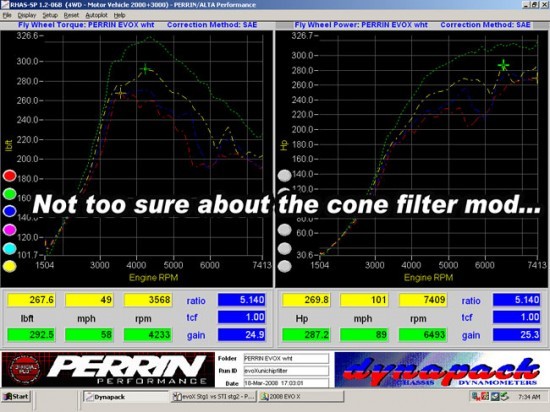 With similar boost and lots more tuning, the cone filter is not a good mod for a tuned ECU.
Some may think that a Manual Boost Controller is a good enough and will get them about the same power. This is not the case. The MBC worked ok, but the ECU just wasn€™t happy€¦€¦.
With similar boost and lots more tuning, the cone filter is not a good mod for a tuned ECU.
Some may think that a Manual Boost Controller is a good enough and will get them about the same power. This is not the case. The MBC worked ok, but the ECU just wasn€™t happy€¦€¦.
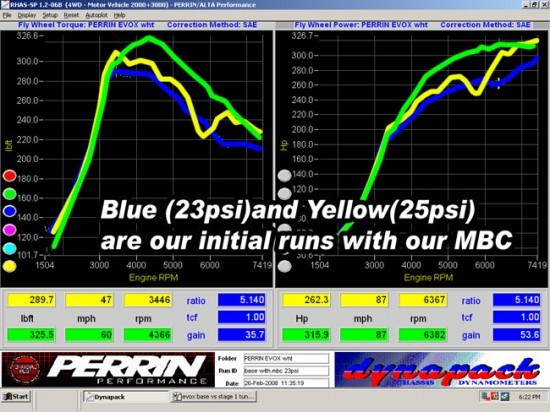 Which power graph would you want???
The green line is the ECU tuned at 23psi, where the blue line is 23psi with our MBC and no ECU tune. The yellow line is the same thing but at 25psi on the PERRIN manual boost controller. So while the MBC is a good mod, and does make power over the stock ECU tuning, the Unichip and our custom tune can do much more.
Which power graph would you want???
The green line is the ECU tuned at 23psi, where the blue line is 23psi with our MBC and no ECU tune. The yellow line is the same thing but at 25psi on the PERRIN manual boost controller. So while the MBC is a good mod, and does make power over the stock ECU tuning, the Unichip and our custom tune can do much more.
CONCLUSION
In conclusion, the Unichip works (NOT REALLY)! It holds the tune, controls boost flawlessly, retards or advances timing, and allows us to lean out the fuel. All these things make more power, which is the goal! After a week or so of playing with the Unichip, we have decided to do a few things different than what we did on our initial tuning. We will be including our EBCS 3 port solenoid in the setup. This makes for an even better more consistent boost curve. Along with this we will have a couple of flying leads that will be there for map switching and water injection. Both setup to go with our PERRIN PWI-1 WI system and its fault detection. If the WI system detects a fault, it will switch to a different map, which has lower boost, retarded timing and richer mixtures. We feel that the Unichip will be a very solid solution for EVO X owners. With consistent and repeatable gains like we have shown, the Unichip should hold is ground even when the flashes come out. Here are a few comparisons to show the kind of power we are making compared to the STI.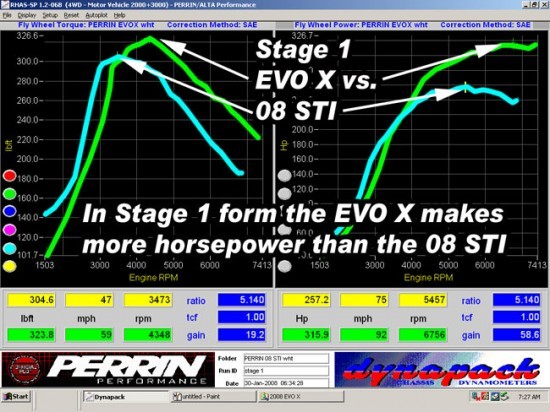 Comparing the Stage 1 EVO X vs. Stage 1 STI, you can see the X would win in most all situations.
Comparing the Stage 1 EVO X vs. Stage 1 STI, you can see the X would win in most all situations.
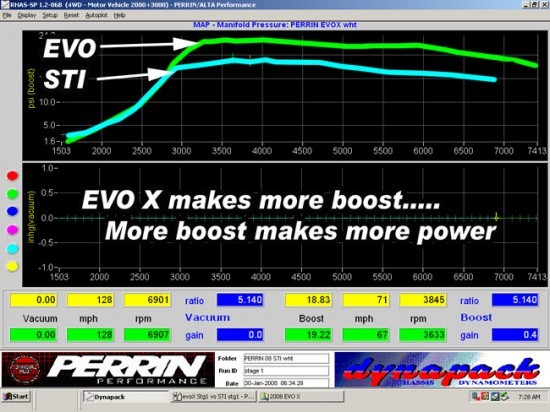 Part of why is the X makes more boost, and has a bigger turbo.
Part of why is the X makes more boost, and has a bigger turbo.
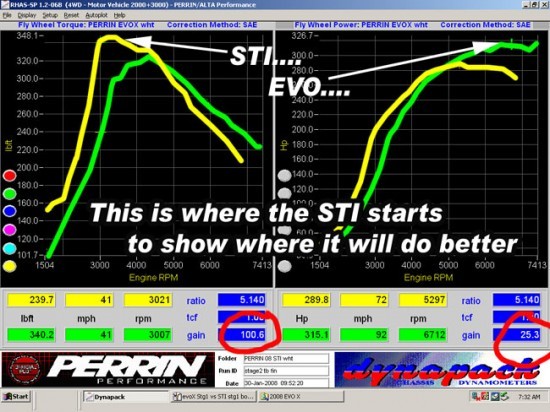 The STI in Stage 2 form (turboback and ECU tune only) is where we start to see the EVO vs. STI trade off of more lower end for top end.
The STI in Stage 2 form (turboback and ECU tune only) is where we start to see the EVO vs. STI trade off of more lower end for top end.


